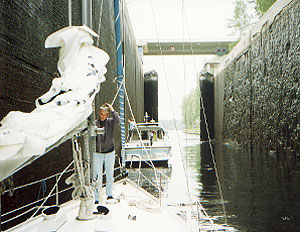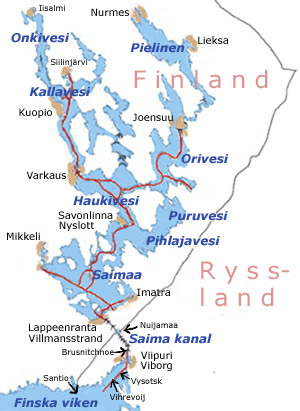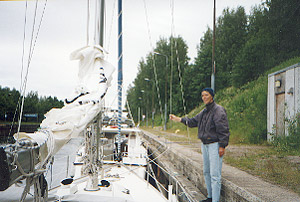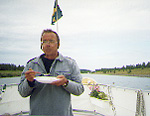Jorma and Lena Bengtsson from Nynäshamn sail an OE 36 called ”Ghita II”. They are both very active in the OE club.
In 1993 Jorma and Lena went sailing to and along the Saimaa canal and the large series of inland seas in the south-east of Finland. Here you can read Jorma’s account of that trip.
The unusual and exciting is often closer than you think. Why not try out the Saimaa canal which begins far inside the Gulf of Finland (Finska viken) directly north west of the Russian city of Vyborg and finishes in the lake of Saimaa directly north-east of the Finnish city of Lappeenranta. In other words, the canal, goes firstly through Russia and afterwards through Finland. Just in front of Lappeenranta you have a fabulous Finnish lake archipelago to sail in. Again if you have the time you should not miss a visit nearby Savonlinna where there is an annual opera festival. Check out with the tourist bureau well before your trip, because it can be very difficult to get tickets.
The Saimaa Canal
The Saimaa Canal was built during the years from 1844 to 1855 under the guidance of the Swedish canal builder Nils Ericson. The Saimaa Canal took on a greater importance in 1968 when it again became connected to the Gulf of Finland as a result of a 1963 agreement between Finland and the then Soviet Union. Since 1991 even foreign leisure boats can use the canal.
The canal is 43 kilometres (26.7 miles) long, of which 33.5 kilometres (20.8 miles) is a man-made canal. Barely half of the stretch is on the Russian side of the border and more than half the stretch on the Finnish side. The canal’s depth is 4.35 metres (14ft 3in).

The canal has eight locks that range in height from 5.5 to 12.7 metres (18ft to 41ft 7in). The locks are both long and broad to accommodate quite large ships. The total height difference over the canal is 77 metres (252ft 7in). Seven movable and six fixed bridges cross the canal. The free sailing height is 24.5 metres (80ft 3in). You can sail along the whole inland lake system for a total distance of around 200 nautical miles, as the majority of the lakes are inter-connected. (See the map.)

You can blame administrative complications and say that it’s too hard to get going. But – most problems can be solved along the way if you simply have the right approach – so, if you don’t consider that anything is “odd”, you follow the rules and instructions and look pleased and happy, then most difficulties can be resolved.
You need to bring your passport but not necessarily a visa. Though without a visa, you will not be able to put into harbour as you transit through Russian territory. On the whole, it is advisable to obtain a visa, because for various reasons you may have to put in to a Russian harbour. A visa (and a passport) are needed if you wish to go to the Russian city of Vyborg or the Russian island of Vysotsk, which is a border control (see below). According to the Finnish regulations a tourist has to submit an advance declaration of his arrival at the Saimaa Canal (on a special form) to the Board of Management of the Saimaa Canal one week in advance. This form is available from the Finnish authorities ” Board of Management of the Saimaa Canal ” (see the address below).
From Sweden to The Gulf of Finland
There are several ways that you can take between Sweden and The Gulf of Finland. You can go in open waters to Finnish Utö, Hangö or still longer to a suitable Finnish border harbour, or alternatively to Mariehamn and then inside the skerries the whole way to the Finnish island of Santio (with a frontier station) near the Finnish-Russian border, where you can be cleared into Finland.
Most of the towns along the Finnish south coast are worth visiting. Why not do what we did: to the east of Helsinki we visited every second town on the outward journey and the remaining ones on the return trip. The stops make a pleasant day trip. Ensure thatyou don’t miss Borgå, which is idyllic with it’s old well-preserved wooden houses. On the sea chart it looks like a difficult trip, but I guarantee an exciting sail over shallow water to a small, winding stream, which wends it way up to Borgå. And sjould you you meet a boat in the stream, it provides that daily dose of excitement and you can enjoy a beer with good conscience.
Russian pilots
From the Finnish island of Santio near the Finnish-Russian border you head easterly towards Vyborg following a well marked route, a so-called toll road (no-man's-land) past the Russian island of Vihrevoij. Afterwards you sail to the island of Vysotsk, which is the border control to Russia and you will eventually reach the first lock (Brusnitchnoe) in the north part of Vyborg. You are obliged to use a Russian pilot between Vysotsk and Brusnitchnoe. The way between Vihrevoij and Brusnitchnoe is around 20 nautical miles long and you can’t diverge from the set route. Russian patrol boats supervise the area. According to available regulations you should give notice that you need a pilot 12 hours in advance and go to the control (and report in again) 4 hours before the pilotage begins.
We had to wait a couple of hours for our Russian pilot who, when he came, sped away with “Ghita” with a engine revolution that we had never even been close to. If you are worried and wonder what smells like burnt rubber – stay calm – it doesn’t have to be the engine, but maybe the Russian cigarettes that he is chain smoking.
Border formalities
Both the arrival and departure customs’ clearance in Russia are simple. You won’t need to search for customs and passport control, as the authorities will approach you even before you have moored. Customs and passport police come onboard and ask to speak to the captain. Now there follows a confused discussion about the number of crew, whether you have weapons, drugs or other illegal objects onboard. This conversation is conducted solely in Russian and concludes with a signature on a document in which, presumably states that all you have said is true. Our knowledge of the Russian language was very limited (nastrovje, da, njet), but everyone seemed happy and so the journey could continue
It is necessary to have a crew list with you. I suggest that you write one out at home and run off a few suitable copies. Double that amount just to be on the safe side. Because you never know what will turn up.
”Ship Chandler’s ” on the island of Vysotsk has conveniently set up a range of tax free goods on the quay within easy reach of passing boats, but take care that you read and understand the customs’ declaration. Remember that you are only in transit. At that time, in 1995, if you lived in a third country, you could not bring even a single drop of alcohol from Russia to Finland. You need to check if that is still the case now that Finland has joined into the EU.
Already at the first lock (Brusnitchnoe) in Saimaa canal you get departure clearance from Russia with the same procedure as in Vysotsk. The first part of the canal, from the border to Finland, works then like a no-man’s-land through Russian territory. Here, there are no settlements apart from a tax-free shop in the middle of the forest by one of the locks. At about the halfway mark, the canal widens into a small lake near the neighbourhood of Nuijamaa. In the middle of the lake is the border between Russia and Finland and you get clearance back into Finland again.

Passing through a lock
Passing through a lock is extremely easy. The locks are supplied with moveable mooring devices which move upwards or downwards in the lock. Just drive in to the nearest hook and catch one in the fore- and one in the aft and everything is ready. If your boat has a cleat in mid-ship, then things are even easier. In that case, you can reach it with a short length of rope and then someone on deck can catch hold of the lock wall at a suitable place.
The canal is wholly administered by Finland (even the part that goes through Russia) and there are Finnish personnel at all of the locks. Pilot and canal fees can be paid at the harbour office in the second to last lock (Mustola). In 1995 our canal fees were 100 FM on the Finnish part. The Russian pilot fee was $33 (US) for groups and for single boats $38 (US). This was for a single trip.

More information
www.fma.fi/saimaacanal/english/
Write to:
Board of Management of the Saimaa Canal
Itäinen kanavatie 2
SF-534 20 Villmanstrand, Finland
Telephon: 00358-204 48 30
saimaankanavan.hoitokunta@fma.fi
You can be sent a leaflet called ”Instructions for boat traffic in the Saimaa canal”. It has all of the information you need to know about the canal journey and is available in several languages.
If you have any questions, you are welcome to contact the crew of Ghita II.
Good luck and have fun!
